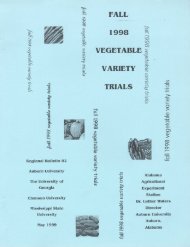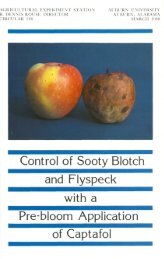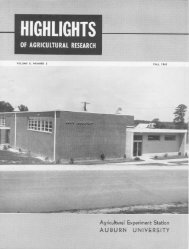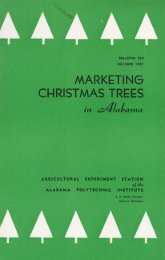1997 Ornamentals Research Report - AUrora - Auburn University
1997 Ornamentals Research Report - AUrora - Auburn University
1997 Ornamentals Research Report - AUrora - Auburn University
You also want an ePaper? Increase the reach of your titles
YUMPU automatically turns print PDFs into web optimized ePapers that Google loves.
4 ALABAMA AGRICULTURAL EXPERIMENT STATION<br />
Styrene-Lined and Copper-<br />
Coated Containers Affect<br />
Production and Landscape<br />
Establishment of Red Maple<br />
THOMAS J. BRASS, GARY J. KEEVER, D. JOSEPH EAKES, AND<br />
CHARLES H. GILLIAM<br />
Densely matted, kinked, and downward-deflected<br />
surface roots are common in vigorous plant species grown in<br />
containers. Transplanting container-grown stock with poor root<br />
development results in poor transplant establishment, increased<br />
trunk breakage, poor mechanical stability, and reduced shoot<br />
growth. Coating the interior wall of containers with various<br />
copper compounds has been effective in limiting root circling<br />
and malformation, but this practice is often inconsistent in<br />
modifying root growth.<br />
Another problem in container production is high<br />
substrate temperatures associated with direct solar radiation<br />
striking the container. High temperatures may lead to an increase<br />
in water usage, as well as suppressed growth, injury, or dieback<br />
of surface roots. A relatively new technique in container<br />
production is the use of compressed styrene sheeting inserted<br />
into containers to insulate the container medium and possibly<br />
alter plant growth. The objective of this study was to determine<br />
the effects of copper-coated and styrene-lined containers on root<br />
and shoot growth of two bare-root red maple cultivars during<br />
production and landscape establishment.<br />
METHODS<br />
In March 1993, an experiment was established<br />
with treatments that included all combinations of 'October<br />
Glory' and 'Northwood' red maple, with and without<br />
styrene lining, and with and without copper coating.<br />
Styrene lining, 0.1 inch thick, was cut and inserted to<br />
cover pot sidewalls. Copper hydroxide at 13.4 ounces per<br />
gallon of latex base (Spin Out) was applied with an<br />
electric paint sprayer directly to the containers' interior<br />
surfaces or directly to the styrene, which was later inserted<br />
into the container. Dormant five-foot-tall whips of each<br />
cultivar were planted in seven-gallon containers of<br />
amended pinebark:sand medium and grown under nursery<br />
conditions. Growth measurements were taken in July and<br />
November 1993. Four plants per treatment were left in<br />
their original containers during 1994 to determine<br />
treatment effects when top growth was disproportionately<br />
great relative to container size. In December 1993, six<br />
plants in each treatment were repotted into 15-gallon, nontreated<br />
black containers. In January 1994, six plants of<br />
each treatment were planted in a Marvyn loamy sand soil<br />
and watered as needed. Growth of all plants was measured<br />
RESULTS<br />
PLANTS GROWN IN SEVEN-GALLON CON-<br />
TAINERS DURING 1993. Between summer and fall<br />
measurements, 'October Glory' grown in pots with styrene grew<br />
more in height than plants in containers without styrene (13.7<br />
inches vs 10.8 inches). At mid-season and at the end of the<br />
season, 'October Glory' had thicker trunks than 'Northwood'<br />
(Table 1). 'October Glory' was taller than 'Northwood' (8.6 feet<br />
vs 8.1 feet) by November. In addition, 'October Glory' had<br />
noticeably heavier branching.<br />
Copper-treated containers effectively controlled<br />
surface root development, regardless of styrene treatment (83%<br />
vs 19% in lined containers; 64.5% vs 17.4% in non-lined<br />
containers). In the absence of copper, percent root coverage of<br />
the medium-container interface (% MCI) was higher for styrenelined<br />
than for non-lined containers (83% vs 64.5%), which may<br />
reflect lower temperatures resulting in less root damage at the<br />
medium-container interface. However, in the presence of copper,<br />
surface root development was greatly reduced and styrene had<br />
no effect. Chemical control of root deflection was achieved for<br />
both cultivars using copper hydroxide with or without styrene<br />
lining, even though root deflection was greater for 'Northwood.'<br />
There were no styrene or copper effects on dry weight<br />
of roots although root systems were visibly more fibrous within<br />
the rootball after the primary roots had come in contact with<br />
copper-treated surfaces. Dry weight of roots was over 2.5 times<br />
higher for 'October Glory' (0.35 ounce) than for 'Northwood'<br />
(0.12 ounce).<br />
PLANTS GROWN IN SEVEN-GALLON CON-<br />
TAINERS DURING 1994. Differences in trunk diameter<br />
between 'October Glory' and 'Northwood' were similar to those<br />
in 1993. Cultivar plant heights were similar, but branching of<br />
'October Glory' was more extensive than that of 'Northwood,'<br />
regardless of copper or styrene treatment. Styrene-lined and copper<br />
treated containers had no effect on height or trunk diameter.<br />
Both cultivars had higher % MCI in styrene-lined than<br />
in non-lined containers, possibly due to lower surface<br />
temperatures in lined containers (Table 2). 'October Glory' had<br />
a higher % MCI in non-lined containers than 'Northwood,' while<br />
% MCI was similar in styrene-lined containers. Both cultivars<br />
had a higher % MCI in containers without copper than in<br />
containers with copper (Table 2). Copper was less effective in<br />
inhibiting circling roots during the second growing season<br />
(60.4%, with copper vs. 8 1.3%, without) as compared to the first<br />
growing season (18.1%, with copper vs. 73.7%, without).<br />
PLANTS REPOTTED INTO 15-GALLON CON-<br />
TAINERS, 1994. Neither styrene nor copper treatments<br />
affected plant height in 1994. However in July and October<br />
1994, trunks of plants originally grown in seven-gallon,<br />
copper-treated containers grew less than those never exposed<br />
to copper (Table 1). 'October Glory' still had thicker trunks<br />
(Table 1), more branching, and denser canopies at the end of<br />
in the summer and fall of 1994. the 1994 grwing seaso than did Northwood.
















